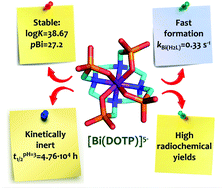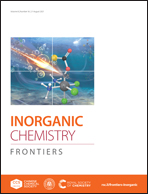Towards 213Bi alpha-therapeutics and beyond: unravelling the foundations of efficient BiIII complexation by DOTP†
Abstract
Bismuth isotopes are attracting increasing attention for their potential applications in diagnostics and therapy. The emerging use of 213Bi in targeted α-therapy (TAT) is a particularly relevant example because it is available from radionuclide generators. A fast formation of stable BiIII-complexes is important for the safe and efficient preparation of labelled (bio)conjugates. Macrocyclic chelating agents are currently the best choice in terms of stability of the corresponding BiIII-complexes. In this work, a thorough study of the thermodynamics and kinetics of formation of BiIII-DOTP including radio-labelling and the comparison with the congener BiIII-DOTA is undertaken. The BiIII-DOTP complex is characterised by a fast formation kinetics (kBi(H2DOTP) = 0.33 s−1), an outstanding thermodynamic stability (log KBiDOTP = 38.67) and an impressive kinetic inertness (t1/2pH=3 = 47 600 h). The results clearly demonstrate that DOTP is a better chelating agent for BiIII both in terms of thermodynamic stability and in terms of kinetics of formation, with clear advantages in the radiolabelling of short-lived bismuth isotopes.



 Please wait while we load your content...
Please wait while we load your content...